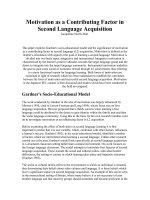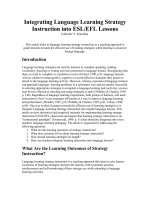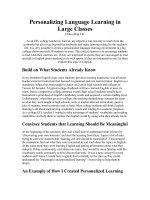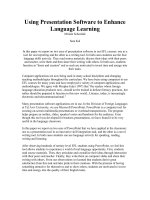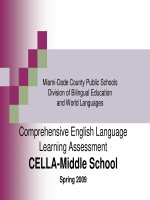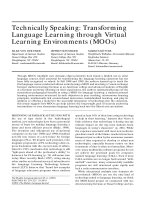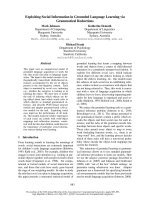Explaining second language learning
Bạn đang xem bản rút gọn của tài liệu. Xem và tải ngay bản đầy đủ của tài liệu tại đây (170.04 KB, 32 trang )
EXPLAINING SECOND
LANGUAGE LEARNING
I
by Lis a Kaci, Jos e phin Obe rhokam p, He ndrik Fitz ne r & Cam illa
Hone rlage
Table of content
Questions
Behaviourism
1.
2.
The innatist perspective
3.
Universal Grammar
“Monitor Model”
Psychological theories
4.
5.
Mimicry and memorization
Cognitivist/developmental perspective
Information processing
Connectionism
The competition model
Discussion
Questions
1.
2.
3.
4.
5.
What are the steps with which Behaviorism explains
language? Name them and give an example.
What are the two different theories about the nature of
Universal Grammar?
What are the 5 hypotheses of Krashen’s “Monitor Model?
Explain two of them briefly.
To what refer “declarative knowledge” and “procedural
knowledge”?
What does the Competition Model explain?
Behaviourism
Theory of learning
Very influential between the 1940s and 1970s
Nurture Environment has great importance
Behaviourism
Explains learning in terms of:
Imitation
Practice
(mimicry)
Reinforcement
Formation of habit =language development
Behaviourism
Video: Learning English, Spanglish
Video: Some funny guy learning English
Behaviourism
Influence on development of audiolingual
teaching and material
great emphasis on mimicry and
memorization
Behaviourism
Contrastive Analysis Hypothesis assumes:
Firs t and targ e t lang uag e
s imilar
Targ e t lang uag e is
le arne d with e as e
First and target language
different
Target language is learned
with difficulty
Behaviourism
But: learners did not do the predicted errors
All learners made nearly the same errors
Influence of first language is the process of
finding similarities
Criticism on Behaviourism and
CAH
Behaviourism +Contrastive Analysis
Hypothesis are inadequate explanations for
second language acquisition
Universal Grammar
Noam Chomsky
Innate linguistic
knowledge which
consists of a set of
principles common to
all languages
Explanation for
second language
acquisition?
Universal Grammar
Lydia White:
best perspective
for second language acquisition;
but nature of Universal Grammar is altered
Robert Bley-Vroman/J acquelyn Schachter:
Not a
good explanation for second language
acquisition: critical period is passed
Vivian Cook
Learners
have more knowledge than input could
give them
Universal Grammar
Different theories about its nature
Nature and availability of Universal Grammar
are the same in first language acquisition and
second language acquisition
Universal Grammar that is present to second
language learners has been altered in its
nature by acquisition of other languages
Monitor Model
Stephen Krashen
Model of second
language acquisition
Influenced by
Chomsky‘s theory of
first language
acquisition
Monitor Model
Based on 5 hypotheses:
1.
2.
3.
4.
5.
Acquisition-Learning Hypothesis
Monitor Hypothesis
Natural Order Hypothesis
Input Hypothesis
Affective Filter Hypothesis
Monitor Model
Psychological theories:
cognitivist/developmental
perspective
Since 1990 central role in second language
acquisition
Computer as metaphor for mind
Capacities
for storage, integration and retrieval
No specific module in brain for
acquisition/learning
UG as explanation for first language
acquisition
Less successful for second language acquisition
Psychological theories:
cognitivist/developmental
perspective
Theories:
Information processing
Connectionism
The
competition model
Information processing
Norman Segalowitz:
Second language
acquisition as the building up of
knowledge for automatic use of speaking and
understanding
Learner first pays attention to any aspect of
language for understanding/production
controlled processing
Experience/practice easier process of
information
quicker automatic access
Information processing
Co ntro lle d pro c e s s ing
Slow access
Under control of
attention
Limited in capacity
Auto matic pro c e s s ing
Quick access
Requires little
attention
Needs little capacity
to perform
Information processing
Robert DeKeyser:
Second language
acquisition as “skill learning”
Learning starts with declarative knowledge
Becomes procedural knowledge through practice
Processes become proceduralized/automized like
other skills
Parallel to development from controlled to
automatic processing
Information processing
De c larative kno wle dg e
Involves acquisition of
isolated facts and rules
knowing that
e .g. knowing that a car
can be drive n
Pro c e dural kno wle dg e
Requires practice
Involves processing of
longer units and
increasing automization
knowing how
e .g. knowing ho w to
drive a car
Information processing
Example: car driving
Begin learning to
drive a car
Close attention to every action/decision
Aware that performances can easily be disturbed (e.g.
talking)
Practice
skill improves
Automization
Experienced driver
Able to pay attention to previously disturbing events
Information processing
Restructuring
Changes
in language behavior
Quality changes in learner‘s knowledge
New forms are not just added to old
Regular systematic reorganization and reformulation
Sudden burst of knowledge
or backsliding
Systematic aspect of learner‘s language incorporates
too much or wrong things
saw +ed
Connectionism
Innate: only the simple ability to learn
Very important: the role of the environment
